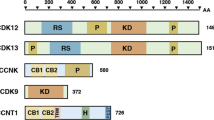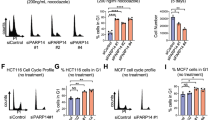Abstract
The helix–loop–helix protein Id1 has been implicated in regulating mammary epithelial cell proliferation and differentiation but the underlying molecular mechanisms are not well characterized. Under low serum conditions, ectopic expression of Id1, but not Id2, allowed continued proliferation of immortalized mammary epithelial cells and breast cancer cells. Conversely, downregulation of Id1 impaired proliferation. The effects of short interfering RNA (siRNA)-mediated downregulation of Id1 were the same as those following downregulation of c-Myc: decreased expression of cyclins D1 and E, reduced phosphorylation of pRb at Ser780 (a site targeted by cyclin D1–Cdk4) and reduced cyclin E–Cdk2 activity. Decreased cyclin D1 expression was an early response to Id1 antisense oligonucleotide treatment. Inhibition of c-Myc function by siRNA, antisense oligonucleotides or a dominant repressor resulted in downregulation of Id1, while ectopic expression of c-Myc resulted in rapid induction of Id1, suggesting that Id1 may be downstream of c-Myc. These data indicate that in mammary epithelial cells, Id1 has cell cycle regulatory functions that are similar to those of c-Myc, and suggest that cyclin D1 may be involved in Id1 regulation of cell cycle progression.
This is a preview of subscription content, access via your institution
Access options
Subscribe to this journal
Receive 50 print issues and online access
$259.00 per year
only $5.18 per issue
Buy this article
- Purchase on Springer Link
- Instant access to full article PDF
Prices may be subject to local taxes which are calculated during checkout







Similar content being viewed by others
References
Alani RM, Hasskarl J, Grace M, Hernandez M-C, Israel MA and Munger K . (1999). Proc. Natl. Acad. Sci. USA, 96, 9637–9641.
Alani RM, Young AZ and Shifflett CB . (2001). Proc. Natl. Acad. Sci. USA, 98, 7812–7816.
Amati B, Alevizopoulos K and Vlach J . (1998). Front. Biosci., 3, d250–d268.
Baldin V, Lukas J, Marcote MJ, Pagano M and Draetta G . (1993). Genes Dev., 7, 812–821.
Blackwell TK, Kretzner L, Blackwood EM, Eisenman RN and Weintraub H . (1990). Science, 250, 1149–1151.
Caplen NJ, Parrish S, Imani F, Fire A and Morgan RA . (2001). Proc. Natl. Acad. Sci. USA, 98, 9742–9747.
Carroll JS, Prall OWJ, Musgrove EA and Sutherland RL . (2000). J. Biol. Chem., 275, 38221–38229.
Carroll JS, Swarbrick A, Musgrove EA and Sutherland RL . (2002). Cancer Res., 62, 3126–3131.
Desprez PY, Hara E, Bissell MJ and Campisi J . (1995). Mol. Cell. Biol., 15, 3398–3404.
Desprez PY, Lin CQ, Thomasset N, Sympson CJ, Bissell MJ and Campisi J . (1998). Mol. Cell. Biol., 18, 4577–4588.
Desprez PY, Sumida T and Coppe JP . (2003). J. Mammary Gland Biol. Neoplasia, 8, 225–239.
Dubik D, Dembinski TC and Shiu RPC . (1987). Cancer Res., 47, 6517–6521.
Elbashir SM, Harborth J, Weber K and Tuschl T . (2002). Methods, 26, 199–213.
Grandori C, Mac J, Siebelt F, Ayer DE and Eisenmann RN . (1996). EMBO J., 15, 4344–4357.
Guan XY, Xu J, Anzick SL, Zhang H, Trent JM and Meltzer PS . (1996). Cancer Res., 56, 3446–3450.
Halevy O, Novitch BG, Spicer DB, Skapek SX, Rhee J, Hannon GJ, Beach D and Lassar AB . (1995). Science, 267, 1018–1021.
Hara E, Yamaguchi T, Nojima H, Ide T, Campisi J, Okayama H and Oda K . (1994). J. Biol. Chem., 269, 2139–2145.
Holmes ML, Haley JD, Cerruti L, Zhou WL, Zogos H, Smith DE, Cunningham JM and Jane SM . (1999). Mol. Cell. Biol., 19, 4182–4190.
Iavarone A, Garg P, Lasorella A, Hsu J and Israel M . (1994). Genes Dev., 8, 1270–1284.
Itahana Y, Singh J, Sumida T, Coppe JP, Parrinello S, Bennington JL and Desprez PY . (2003). Cancer Res., 63, 7098–7105.
Kitagawa M, Higashi H, Jung H-K, Suzuki-Takahashi I, Ikeda M, Tamai K, Kato J-Y, Segawa K, Yoshida E, Nishimura S and Taya Y . (1996). EMBO J., 15, 7060–7069.
Kolligs FT, Nieman MT, Winer I, Hu G, Van Mater D, Feng Y, Smith IM, Wu R, Zhai Y, Cho KR and Fearon ER . (2002). Cancer Cell, 1, 145–155.
Lin CQ, Singh J, Murata K, Itahana Y, Parrinello S, Liang SH, Gillett CE, Campisi J and Desprez PY . (2000). Cancer Res., 60, 1332–1340.
Massari ME and Murre C . (2000). Mol. Cell. Biol., 20, 429–440.
Miyoshi K, Meyer B, Gruss P, Cui Y, Renou J-P, Morgan FV, Smith GH, Reichenstein M, Shani M, Hennighausen L and Robinson GW . (2002). Mol. Endocrinol., 16, 2892–2901.
Mori S, Nishikawa S-I and Yokota Y . (2000). EMBO J., 19, 5772–5781.
Musgrove EA, Hunter LK, Lee CS, Swarbrick A, Hui R and Sutherland RL . (2001). J. Biol. Chem., 276, 47675–47683.
Musgrove EA, Lilischkis R, Cornish AL, Lee CS, Setlur V, Seshadri R and Sutherland RL . (1995). Int. J. Cancer, 63, 584–591.
Norton J . (2000). J. Cell Sci., 113, 3897–3905.
Ohtani N, Zebedee Z, Huot TJG, Stinson JA, Sugimoto M, Ohashi Y, Sharrocks AD, Peters G and Hara E . (2001). Nature, 409, 1067–1070.
Ohtsubo M, Theodoras AM, Schumacher J, Roberts JM and Pagano M . (1995). Mol. Cell. Biol., 15, 2612–2624.
Oster SK, Ho CSW, Soucie EL and Penn LZ . (2002). Adv. Cancer Res., 84, 81–154.
Parrinello S, Lin CQ, Murata K, Itahana Y, Singh J, Krtolica A, Campisi J and Desprez PY . (2001). J. Biol. Chem., 276, 39213–39219.
Peverali F, Ramqvist T, Saffrich R, Pepperkok R, Barone M and Philipson L . (1994). EMBO J., 13, 4291–4301.
Prabhu S, Ignatova A, Park S and Sun X . (1997). Mol. Cell. Biol., 17, 5888–5896.
Prall OWJ, Rogan EM, Musgrove EA, Watts CK and Sutherland RL . (1998). Mol. Cell. Biol., 18, 4499–4508.
Prall OWJ, Sarcevic B, Musgrove EA, Watts CKW and Sutherland RL . (1997). J. Biol. Chem., 272, 10882–10894.
Schoppmann SF, Schindl M, Bayer G, Aumayr K, Dienes J, Horvat R, Rudas M, Gnant M, Jakesz R and Birner P . (2003). Int. J. Cancer, 104, 677–682.
Schreiber-Agus N, Chin L, Chen K, Torres R, Rao G, Guida P, Skoultchi AI and DePinho RA . (1995). Cell, 80, 777–786.
Sikder HA, Devlin MK, Dunlap S, Ryu B and Alani RM . (2003). Cancer Cell, 3, 525–530.
Sutherland RL, Prall OW, Watts CK and Musgrove EA . (1998). J. Mammary Gland Biol. Neoplasia, 3, 63–72.
Swarbrick A, Lee CS, Sutherland RL and Musgrove EA . (2000). Mol. Cell. Biol., 20, 2581–2591.
Tanner MM, Tirkkonen M, Kallioniemi A, Isola J, Kuukasjarvi T, Collins C, Kowbel D, Guan XY, Trent J, Gray JW, Meltzer P and Kallioniemi OP . (1996). Cancer Res., 56, 3441–3445.
Tikhonenko AT, Black DJ and Linial ML . (1996). J. Biol. Chem., 271, 30741–30747.
Tournay O and Benezra R . (1996). Mol. Cell. Biol., 16, 2418–2430.
Volpert OV, Pilli R, Sikder HA, Nelius T, Zaichuk T, Morris C, Shiflett CB, Devlin MK, Conant K and Alani RM . (2002). Cancer Cell, 2, 473–483.
von der Lehr N, Johansson S, Wu S, Bahram F, Castell A, Cetinkaya C, Hydbring P, Weidung I, Nakayama K, Nakayama KI, Soderberg O, Kerppola TK and Larsson LG . (2003). Mol Cell, 11, 1189–1200.
Wang J, Xie LY, Allan S, Beach D and Hannon GJ . (1998). Genes Dev., 12, 1769–1774.
Watson PH, Pon RT and Shiu RPC . (1991). Cancer Res., 51, 3996–4000.
Wingender E, Chen X, Fricke E, Geffers R, Hehl R, Liebich I, Krull M, Matys V, Michael H, Ohnhauser R, Pruss M, Schacherer F, Thiele S and Urbach S . (2001). Nucleic Acids Res., 29, 281–283.
Yates PR, Atherton GT, Deed RW, Norton JD and Sharrocks AD . (1999). EMBO J., 18, 968–976.
Acknowledgements
We thank the following colleagues: Joseph Webster (Centenary Institute of Cancer Medicine and Cell Biology, Sydney) and Dr Rebecca Newton for flow cytometric cell sorting; Dr Pierre Yves Desprez (Geraldine Brush Cancer Research Institute, San Francisco) and Dr Jason Carroll for helpful discussions, reagents and advice; and Dr Rania Kairouz and Dr Sophie Doisneau-Sixou for their contributions to some experiments. This research was supported by the National Health and Medical Research Council of Australia, The Cancer Council NSW, The Cure Cancer Australia Foundation and The Association of International Cancer Research. AS was a recipient of an Australian Postgraduate Award and a Fatemeh Moradzadeh Fellowship. CEC is a recipient of an Australian Postgraduate Award, the LH Ainsworth Scholarship for Cancer Research and the Beth Yarrow Scholarship in Medical Science.
Author information
Authors and Affiliations
Corresponding author
Rights and permissions
About this article
Cite this article
Swarbrick, A., Åkerfeldt, M., Lee, C. et al. Regulation of cyclin expression and cell cycle progression in breast epithelial cells by the helix–loop–helix protein Id1. Oncogene 24, 381–389 (2005). https://doi.org/10.1038/sj.onc.1208188
Received:
Revised:
Accepted:
Published:
Issue Date:
DOI: https://doi.org/10.1038/sj.onc.1208188
Keywords
This article is cited by
-
ID1 confers cancer cell chemoresistance through STAT3/ATF6-mediated induction of autophagy
Cell Death & Disease (2020)
-
The expression of VE-cadherin in breast cancer cells modulates cell dynamics as a function of tumor differentiation and promotes tumor–endothelial cell interactions
Histochemistry and Cell Biology (2018)
-
The Id-protein family in developmental and cancer-associated pathways
Cell Communication and Signaling (2017)
-
Inflammatory properties of inhibitor of DNA binding 1 secreted by synovial fibroblasts in rheumatoid arthritis
Arthritis Research & Therapy (2016)
-
Relevance of HCN2-expressing human mesenchymal stem cells for the generation of biological pacemakers
Stem Cell Research & Therapy (2016)



